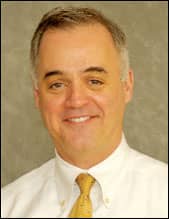Bruce V. Livingston, Boyd Industries Inc Terry Gunning, Cadent

Video Games and Chairside Changes
Bruce V. Livingston is president of Boyd Industries Inc, Clearwater, Fla, which has been in business for 50 years. Livingston has been with the company for 23 years. He has a bachelor’s of science degree in marketing and management from Miami University, Oxford, Ohio.
OP: What type of products does your company provide to orthodontists?

Livingston: Boyd Industries offers a diverse product line, which includes treatment chairs, delivery units, task and intraoral lighting, practitioner/assistant seating, steri-centers, and E2 (entertaining environments) gaming systems for waiting areas and for chairside.
OP: Tell us about your most popular product.
Livingston: Our most popular and possibly fastest-growing product is our E2 line of gaming systems, which we introduced 2 years ago. The concept of this gaming line is to provide in-office entertainment for patients, siblings, and parents while they are waiting in your office. The system is compatible with all gaming platforms (PS2/PS3, Xbox360, Wii, and PSP). The gaming platform is enclosed in a locked climate-controlled environment with secured game system controllers. We also offer different color selections for the accent panel to match any office dÉcor. The gaming system can be customized with a company logo that is placed on the front panel of the gaming console. PSP is only available in a post, cabinet, or wall mount.
OP: How do your chairside delivery units make orthodontic treatment easier?
Livingston: Ergonomics is probably the most valuable asset that our delivery units provide to increasing the ease of treatment and productivity in a practice. In today’s orthodontic market, the demand for chairside information and instrumentation is critical to efficient productivity. Computers are here to stay in the treatment area, and provide an essential tool to providing patient history and diagnostics to the practitioner and staff. All Boyd “computer-ready” delivery units have the following features to facilitate the use of computers: a GFI duplex outlet that is fuse-controlled to prevent the “shorting out” of components, electrical components that are isolated from water-related instrumentation, Cat 6 network cabling, waterproof umbilicals on all electricals to prevent a shock hazard, access holes for monitor and mouse cables, and a variety of flat-screen monitor mounts.
Boyd also offers side- and rear-delivery concepts with external or retraction capabilities of component tubings.
The storage of ancillary supplies at chairside keeps staff from having to get up and search for supplies used during the day. Boyd delivery units feature different drawer configurations that can be customized.
Helping Orthodontists Start with the End in Sight
Terry Gunning joined Cadent, Carlstadt, NJ, as CEO in 2007.
OP: How do your 3D digital solutions improve treatment efficiency?

Gunning: Cadent’s orthodontic services, marketed under the brand name OrthoCAD™, provide 3D digital models for orthodontic treatment planning and for the correct placement of appliances. OrthoCAD study models allow the orthodontist to make accurate measurements for the treatment plan, eliminate plaster model storage and retrieval issues, and improve communication with health care consultants and patients. OrthoCAD’s iQ™ service uses software to allow practitioners to simulate treatment strategies and select and execute the most appropriate treatment plan, including optimal positioning of orthodontic brackets. iQ allows the ability to see post-treatment results on the screen before treatment even begins. iQ provides an 80% reduction in practitioner time on bonding day, fewer repositions and wire bends, a 25% reduction in treatment time, and 25% additional time in the schedule.
OP: What type of training does your company provide to orthodontists?
Gunning: Our goal is to provide world-class training that ensures an easy transition to our digital services. The OrthoCAD software support team offers free software telephone training for orthodontists and members of their staff. For OrthoCAD iQ, a clinical trainer travels to the orthodontist’s location and teaches the entire office the clinical steps that are required to achieve successful treatment results. The OrthoCAD iQ in-house orthodontists conduct case approval and follow-up telephone training sessions, and answer any questions the practitioner may have. Our regional representatives are also available to provide assistance to offices.
OP: How long has Cadent provided products to the orthodontic market?
Gunning: Since 1999, Cadent has processed more than 1 million OrthoCAD digital study model cases and 35,000 bracket placement cases worldwide. Currently, close to 15% of US orthodontic cases begin with the use of OrthoCAD products.










